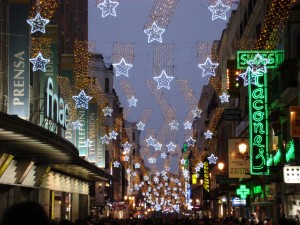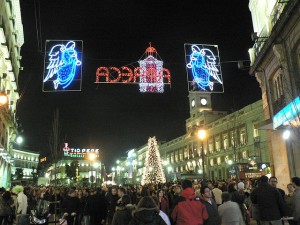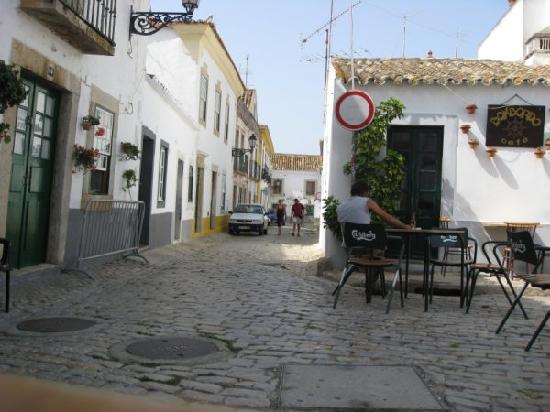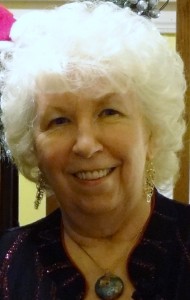At the very end of 1990, Dan and I left Halifax for Europe. This is one of the columns I wrote about that trip. It was published in The Daily News on January 15, 1991.
As midnight begins to strike on December 31 in Madrid’s central square, the Puerto del Sol, the lights are lowered and silence falls over the thousands of people gathered there. In accordance with an old tradition, each person eats one green grape at each stroke. The feeling of anticipation and tremendous excitement builds and builds and finally, at the last stroke, pandemonium erupts.
A large ball of light drops from the clock tower, a volley of fireworks fills the sky, champagne corks pop and plastic champagne flutes appear instantly out of pockets, everyone hugs and kisses and cheers and dances, and a sign of lights spells out Feliz Ano Nuevo – Happy New Year.
This year, to make the scene almost unbelievably perfect, there was a bright, beautiful full moon looking down on it all. This year also, my husband Dan and I were among the thousands in the Puerto del Sol and we both have to say, it was our most exciting New Year’s Eve ever.
We had arrived in Madrid only a couple of hours before, on a plane from Amsterdam with only about eight other people. The Madrid airport was dim and nearly empty and we dragged ourselves sleepily through it as befits two travellers who had left Halifax nearly 24 hours before and had not been to bed for a day and a half.
What a difference a couple of hours can make.
The taxi driver who took us downtown assured us that we wouldn’t sleep a wink that night because of the fiesta; after all, our hotel fronted directly on the square where all the festivities would occur. We didn’t expect to have any trouble sleeping but, truly, we became more and more awake as we got closer to the action.
The Christmas lights in central Madrid were dazzling – large garlands of lights strung across the wide boulevards, every street with a different pattern of Santas, bells, candles. Lights were entwined in the branches of all the big trees along the streets, many businesses and institutions displayed elaborate and very beautiful manger scenes.
After we’d checked in to the hotel, Dan went out to see if we could get some champagne. He was back in minutes to report that they were selling champagne on the streets. Later when we both went out, we discovered that champagne was just one of the things being sold on the streets – there were temporary booths and tables of green grapes, ice cream and popcorn, scarves and belts, purses, cigarettes and lottery tickets.
(This is a generic photo of Puerto del Sol on New Year’s Eve but that’s our hotel in the background, with the Tio Pepe sign on top.)
The crowds gathered through all the surrounding streets and a most interesting crowd it was. There were babes in arms, toddlers and little children dressed in their best, young couples in gowns, full-length fur coats and tuxedos, casually dressed parents and teens in jeans, grandmothers and grandfathers dressed sedately for a big evening out.
After the big finale, it was a party we hated to leave but good sense prevailed and, contrary to our taxi driver’s prediction, we had no trouble at all having a sound night’s sleep.
We went out on New Year’s Day expecting to see the kind of deserted streets we’d see in Canada on a holiday – but not in Spain. The Spaniards spend much of their lives outside their homes and they were certainly out on Jan. 1, 1991. Many were just having their regular walk – the paseo; others were checking out the wares of the vendors who were back in the streets and in the squares; still others were crowded into noisy bars and restaurants. Spaniards are a very social people and there are many occasions to be turned into social events – from morning cafe con leche to the very late-evening dinners they’re famous for.
Later on New Year’s Day, we went to an ancient church in central Madrid. As the concept of queuing is simply unknown in Spain (or at least unpractised, unless they’re buying lottery tickets), it was interesting to see that the people who wished to take communion simply advanced to the altar in clusters and took their chances. It appeared that everyone was taken care of, however. (While they were up taking communion, other people would come and take their seats but no one seemed to mind.)
I’ve been to Spain many times since the first time I went there in 1970, over 20 years ago. I’ve always said that I go because I like the climate, I like the landscape and I like the people.
There have been many changes in the country since then but, fortunately, some things never change: the climate, the landscape and, at least in the superficial ways that I was able to observe on a short vacation, the people. They remain gregarious and outgoing, treating somewhat timid Canadian strangers the way they treat each other, living their lives loudly and unself-consciously.
I suppose that’s why they know how to throw a great New Year’s Eve party and altogether, it was an unforgettable experience to ring in 1991 with so many of them.






